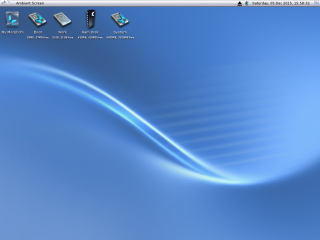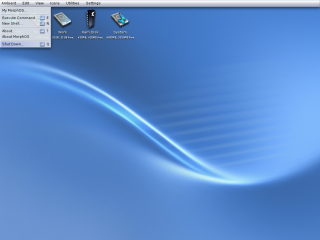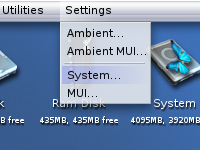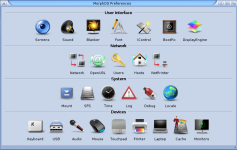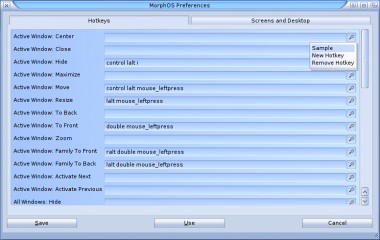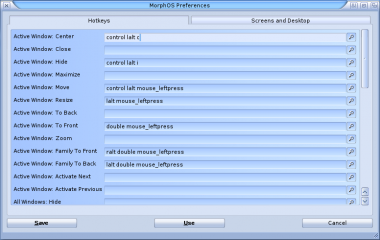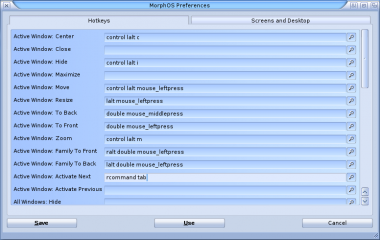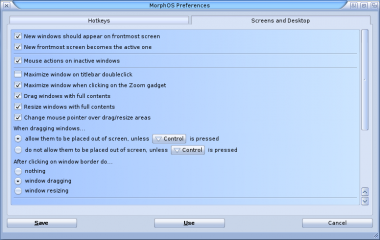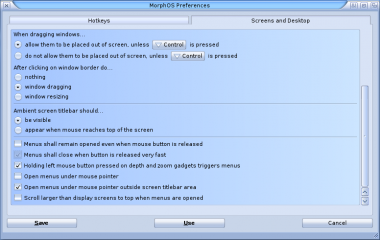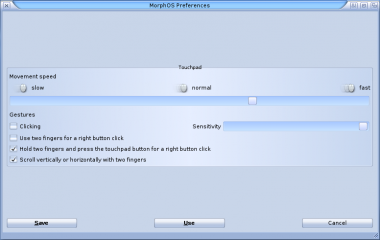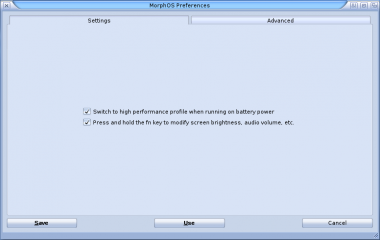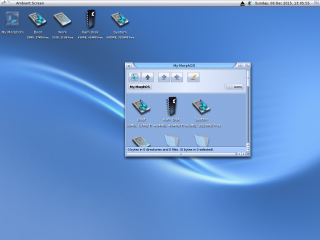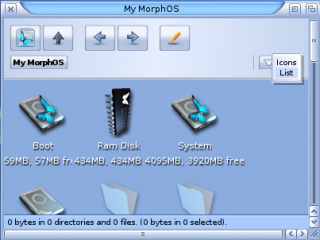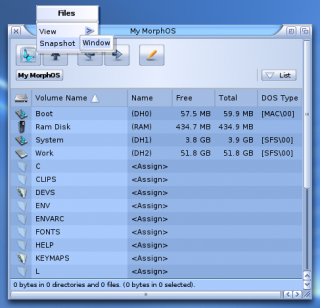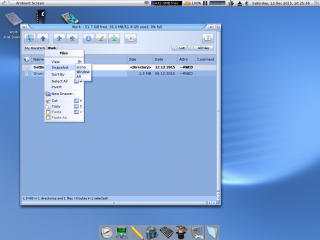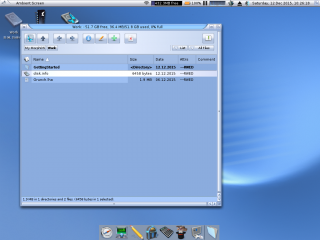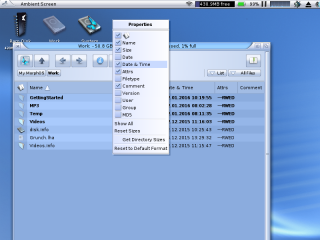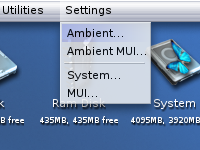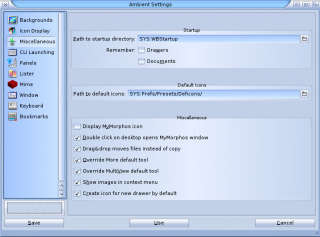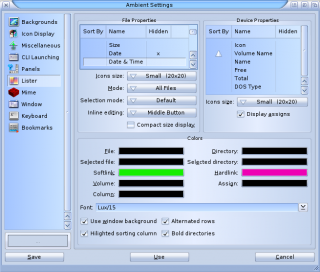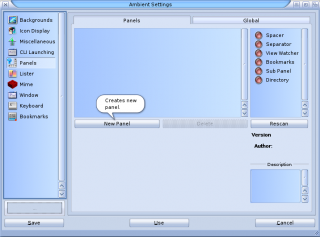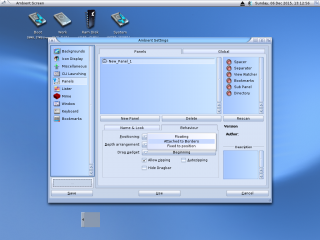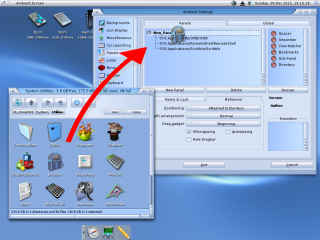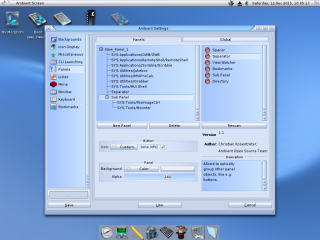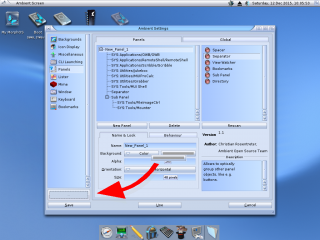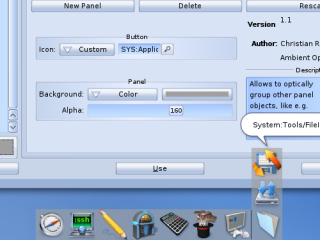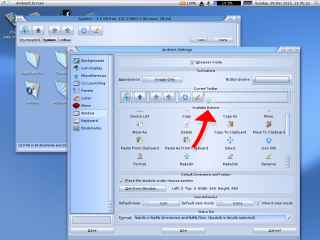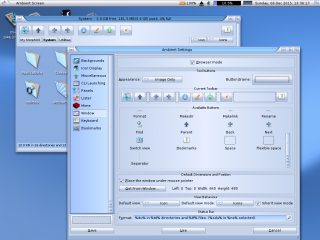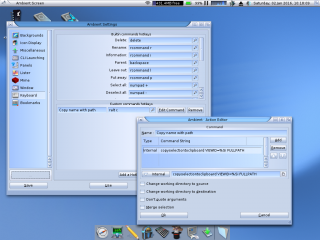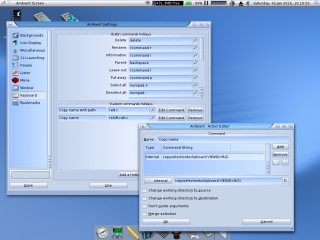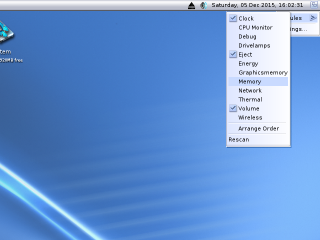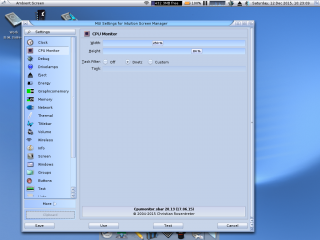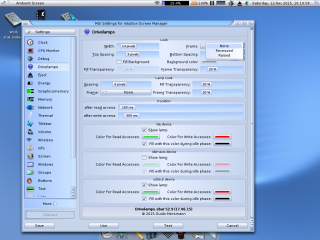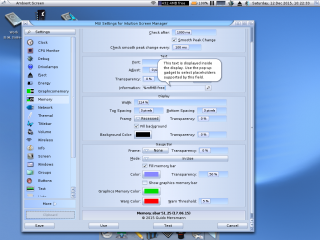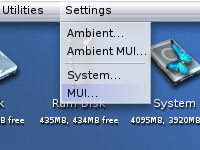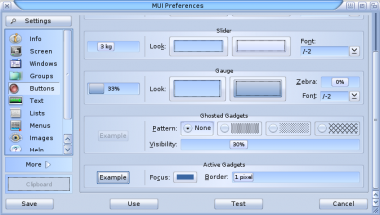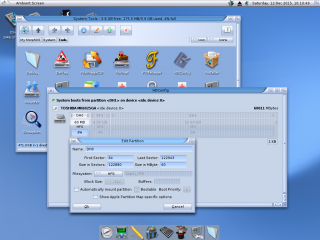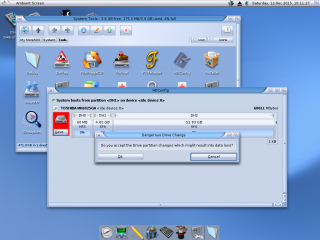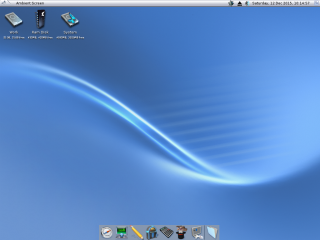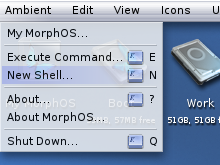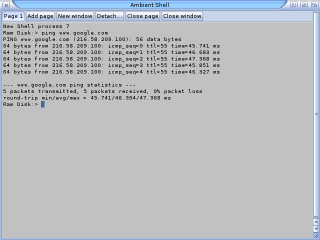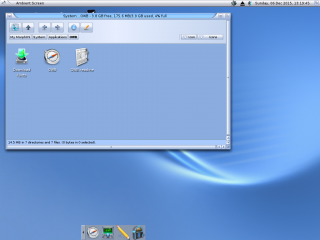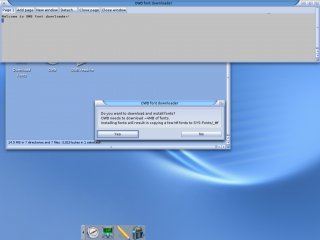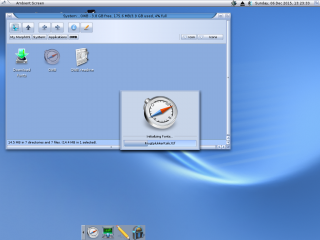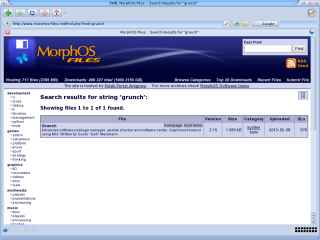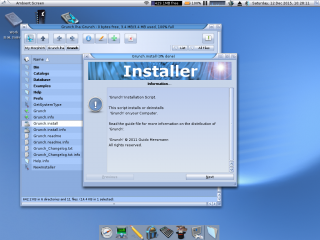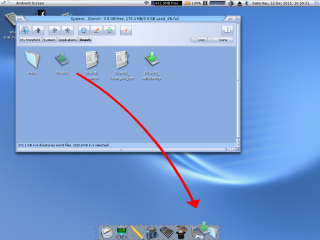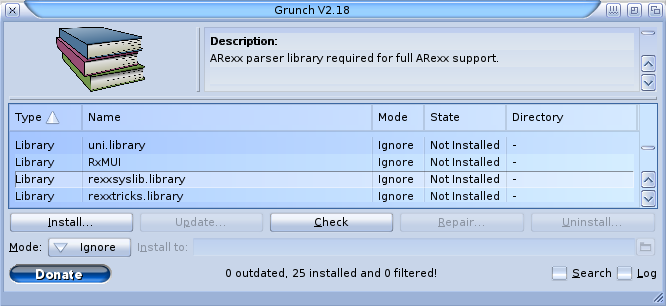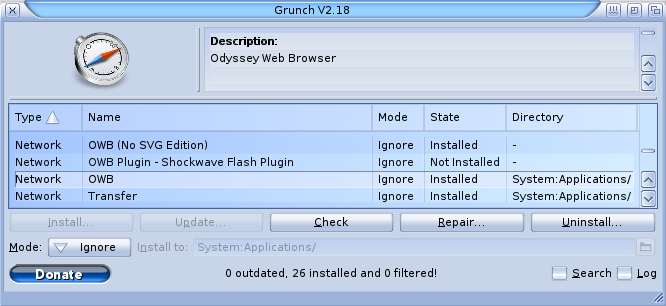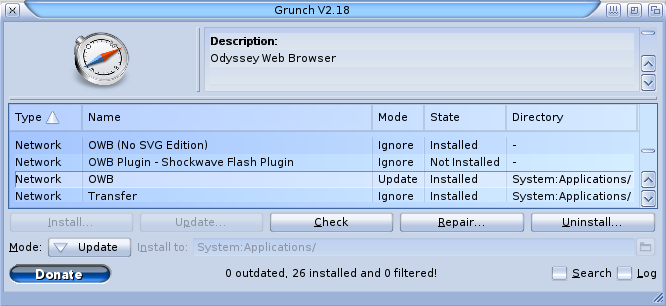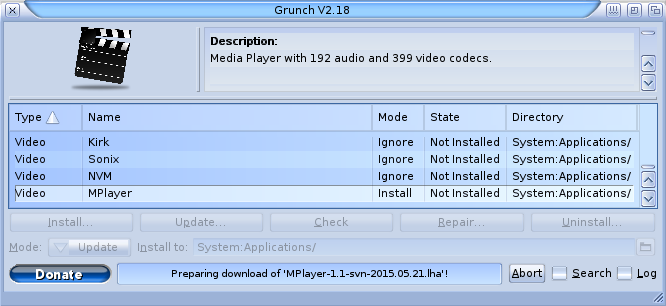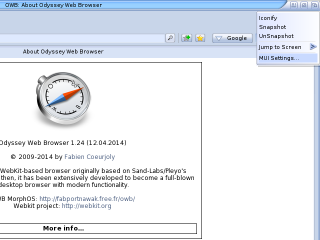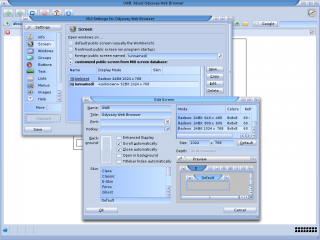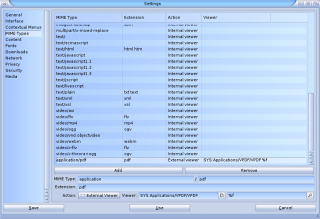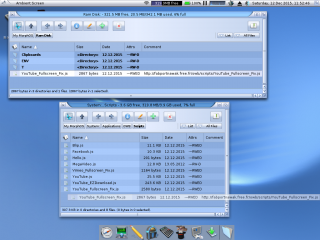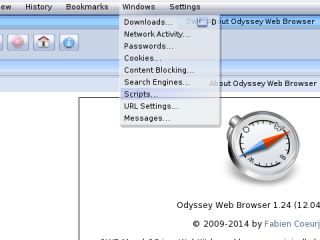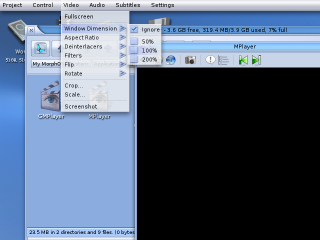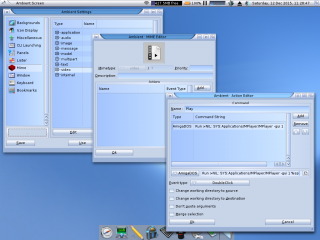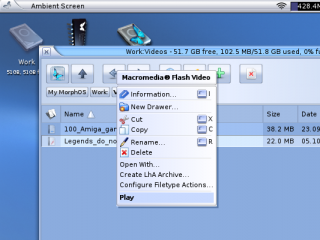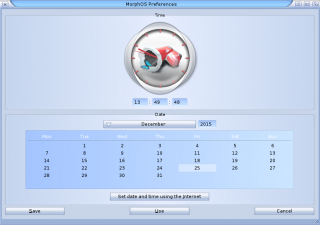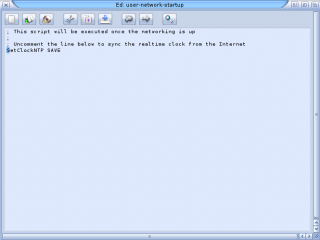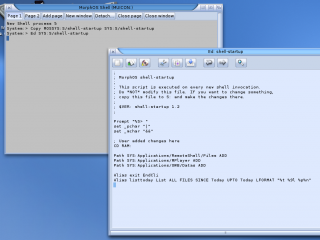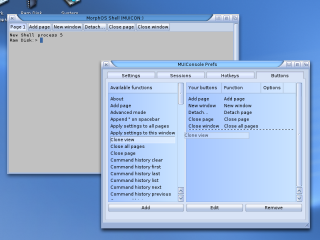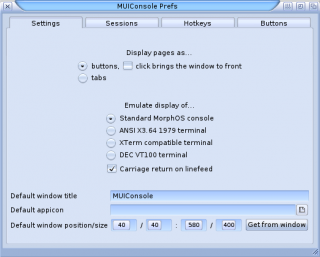Difference between revisions of "Getting Started"
From MorphOS Library
| Line 156: | Line 156: | ||
If you now select any files on an Ambient window and press the ''ralt c'' keyboard combination, names and paths of the files get copied to the clipboard and can be pasted to any other application. With ''rshift ralt c'' combination only the names without paths get copied. | If you now select any files on an Ambient window and press the ''ralt c'' keyboard combination, names and paths of the files get copied to the clipboard and can be pasted to any other application. With ''rshift ralt c'' combination only the names without paths get copied. | ||
: [[File:GettingStarted_Ambient_Settings_Keyboard1.png|320px]] [[File:GettingStarted_Ambient_Settings_Keyboard2.png|320px]] | : [[File:GettingStarted_Ambient_Settings_Keyboard1.png|320px]] [[File:GettingStarted_Ambient_Settings_Keyboard2.png|320px]] | ||
| + | |||
| + | An another example which will extract any selected archive file to the ram disk. | ||
| + | * Click the '''Add a Hotkey''' button, define name to '''Extract to RAM''' and hotkey for example to '''lshift control e'''. Click the '''Edit Command''' button and the '''Add''' button on the Action Editor window. Leave the action type to '''AmigaDOS''', type in the command '''XADUnFile %sp RAM:''' and press enter. Click '''Ok'''. | ||
Revision as of 13:14, 2 January 2016
Contents
- 1 A Beginner's Guide to MorphOS
- 2 Getting Comfortable with the User Interface and the Ambient Desktop
- 3 Installing, Updating, and Configuring Essential Software
- 4 More Configuring
A Beginner's Guide to MorphOS
You have installed MorphOS to a compatible machine, but... now what? You could always go and install a pre-configured package like Chrysalis, but you would end up with a system configured for someone else's taste and you still wouldn't know how to actually use the operating system. If you are in this situation and you would like to learn how MorphOS works, this is a tutorial for you! The tutorial will guide you through the things you should do and notice after a fresh install, with practical examples from basic configuration options to installing new software. It won't cover all the details and is just an opinion how to proceed, but it should give you some knowledge how to continue on your own and make your own decisions.
Getting Comfortable with the User Interface and the Ambient Desktop
The First Boot
After a boot you're presented with the plain looking Ambient, the desktop environment of MorphOS. The first thing you should learn is to get familiar with the basic usage, and to tune the usability settings so that they won't annoy you. The worst thing is if a user plays around a bit and just curses at the system if it doesn't work like expected or wanted. You aren't forced to just one kind of behaviour with MorphOS!
The right mouse button is widely used on MorphOS and if you're using a device without a physical button for it, check the tips over here. Pressing the right mouse button over the Ambient screen opens Ambient's pulldown menus where you can find few important options. For example, options to shut down the system, to open a new shell window, or to open system settings.
System Settings
The MorphOS Preferences application is used to edit system-wide settings. It can be launched from the Ambient's pulldown menu by selecting the "Settings->System..." menu option or by browsing to the System:Prefs/ drawer and double clicking the Preferences icon.
Screens
If MorphOS didn't get the optimal resolution of your monitor with DDC, a different screen mode can be selected from the Screens settings. If the wanted mode isn't seen there, open the Monitors settings instead to create a completely new mode.
If you have a graphics card with low amount of memory, you can try to get the memory consumption smaller by disabling the Enhanced Display setting (3D accelerated graphics functions for 2D screens) or by reducing the color depth. More information can be found from here.
MorphOS skins (themes for the graphical appearance) can also be changed from the Screens settings.
IControl
IControl settings are the most important settings for the overall usability experience. This is the place to look to avoid the usual comments like "Why doesn't X work like Y in the other OS?", "Why there isn't a feature Z?", "I can't use a system like this!". Everyone should check these settings first before going any further.
Hotkeys
MorphOS has many nice features to be used with keyboard shortcuts or mouse buttons, but only few are activated by default. Let's activate more!
To add a new hotkey for the wanted function click the popup button on the right side, select "Sample", and press the wanted keyboard combination. The pressed combination is then recorded to the corresponding line and should be shown there. Repeat the procedure if you didn't get it as wanted on the first try. Changed settings will be taken in use after you click Save or Use button.
Here is how to set the "control left-alt c" keyboard combination to center the active window on screen:
Here are some other recommendations to activate, but feel free to use your own preferences for the hotkeys:
- Active Window: To Back - double click with the middle mouse button, to send a window back of other windows.
- Active Window: Zoom - "control left-alt m", to toggle between maximizing and minimizing of a window.
- Active Window: Activate Next - "left-command tab", to have the alt-tab functionality found on many other operating systems. Using ctrl-tab or alt-tab isn't recommended because they would overlap with the shell's functionality on MorphOS. Command-tab happens also be the same with OSX.
Note: You can also add several hotkeys for a function by selecting the New Hotkey option from the popup button's menu.
Screens and Desktop
Important options how windows and menus behave can be found from the Screens and Desktop settings.
I'd recommend to turn on the Maximize window when clicking on the Zoom gadget option. The Zoom gadget will then toggle the window size between the full screen (with screen title bar still visible) and the initial window size and position. I find it much more comfortable than the legacy placement between two obscure positions. The previously configured Zoom hotkey will also work better with this option enabled.
If you prefer to be able to drag windows out of the screen without pressing any qualifier key, like on mainstream systems, select the When dragging windows... allow them to be placed out of screen, unless Control is pressed option.
The default behaviour of the pulldown menus may be a bit unfamiliar for the old Amiga users, but there are several options to get them as wanted. I like to disable the Menus shall remain opened even when mouse button is released option and enable the Open menus under mouse pointer outside screen titlebar area option.
Touchpad
If you're using a laptop system, check the Touchpad setttings. You might want to disable clicking from the pad to avoid any accidental clicks.
Laptop
If you're not a Mac user, you might find it odd that you need to press the fn key when using the function keys to normal activities, and not when modifying for example the screen brightness. The Press and hold the fn key to modify screen brightness, audio volume, etc. option will change the functionality the other way around.
Some systems also have the Automatic LCD brightness and keyboard backlight control option here. Disable it if you're annoyed by changing lightning.
Ambient Windows
The first icon you see on the Ambient desktop is the "My MorphOS" icon. By double clicking it you'll get a window with icons of all volumes and assigns found in the system, it works like a root directory with a quick access to different locations.
If you find it a bit clumsy in the icon mode, like I do, you can change the view to the list mode from the cycle button on the right side of the window.
With the default settings Ambient doesn't remember the changed mode or other window properties next time you open it, but you can right click the window border or an empty area on the file lister to get a window context menu and select the "Snapshot->Window" option to save the window properties. Default position and size for a window can be saved that way too. If you did define the centering hotkey earlier, you can try it now :)
The same can be made for the normal directory windows too. While "My MorphOS" window settings are exceptionally saved to Ambient's configuration files, normal directories' settings are saved to an icon file (a file with .info extension). If you change and save the mode for the Work: partition for example, you see a disk.info file appearing there.
Displayed columns can be selected by right clicking the column title area, but modify the default lister settings for your liking before starting to save settings for individual windows.
Ambient Settings
Ambient is actually a separate application itself and it has its own settings separated from the general system preferences. The previously mentioned system settings affect to all programs and screens, but strictly desktop related settings are found in the Ambient settings. The Ambient Settings window can be opened by selecting the "Settings->Ambient..." option from the Ambient's pulldown menu.
Miscellaneous
The Miscellaneous page on the Ambient settings has a nice option to get the My MorphOS window opened when double clicking anywhere on the empty area of the desktop. It really speeds up the working when you don't have to move the mouse a long way to the top corner or dig the icon out from under some other windows. Enable it with the Double click on desktop opens MyMorphOS window option.
The My MorphOS icon is just wasting the space on the desktop after the previous setting and you can hide it by disabling the Display MyMorphOS icon option.
If you like to have a bit more eye candy on the context menus, you can also enable the Show images in context menu option while you're here.
Lister
Default properties of list mode Ambient windows can be changed from the Lister settings. Disable the Compact size display if you want to see exact file sizes in bytes always. You may also want to select different columns to be shown in the listers by double clicking items on the File Properties list to set them hidden or shown. Date & Time instead of just Date would probably be a common choice.
Panels
Many new users are wondering if there is any kind of dock application on MorphOS, because there isn't any shown by default. MorphOS has panels for that and you can have as many panels as you want on the desktop, arranged horizontally or vertically. The panels have features like zipping to hide and unhide them, sub panels and other Panel Object plugins, etc. There just isn't any configured by default and user can create a panel or panels how he likes.
To create a new panel, open the Panels page on the Ambient settings and click the New Panel button.
An empty panel can be dragged anywhere and you can look some of its settings on Name & Look and Behaviour tabs. If you want to place the panel to a screen border the Attached to Borders option makes it easier. The Alpha option controls the transparency of a panel, but it only works if the Enhanced Display option for the Ambient screen enabled and working. The same applies to the Hide Dragbar option too.
Programs can be added to the panel by dragging and dropping their icons to the panel list to the wanted position on the list tree, or to the panel itself. Items in the panel list can be rearranged by drag and drop too.
Available Panel Objects are listed on the right-hand side and they can be dragged and dropped to any position on the panel tree. All items on the panel may have their own settings, which are shown when an item is clicked once with the left mouse button. In this example picture a new sub panel has been created and its icon image is being changed to a custom one.
If you want to clone the color settings from the main panel to a sub panel, you can use the MUI clipboard to temporarily store a setting. Drag & drop the wanted color button to the clipboard button.
Then activate the sub panel settings and drag & drop the clipboard button to the sub panel's color button.
And here's a picture of the created panel and its sub panel in action. Remember to click the Save button. The panels also have a context menu when clicked with the right mouse button and you'll have a quick access to the panel settings and some other options there.
Window
Ambient windows are very configurable and users should at least check available buttons for the toolbar. Even adding few buttons can make a difference to the usability. The buttons and other items can be dragged from the Available Buttons list to the Current Toolbar group, and vice versa to remove them from the toolbar. All changes are updated in real time to any open Ambient windows.
In this example picture Makedir and Delete buttons are separated with the Space button and have been added in a row with other buttons. Also the Bookmarks button has been added as the last item on the toolbar. It stays always at the right border no matter how big a window is, because it's been added after the Flexible space button.
Keyboard
Builtin Commands Hotkeys
Check the Ambient hotkeys from this section and change them for your liking, especially if you have a laptop without the numeric keypad, because many of the hotkeys are using numpad combinations by default. I, for example, have used to have the Cycle Mode on the key above the tab key and Cycle Submode with the shift key added, it's somehow quicker to use them from there than from the numpad.
Custom Commands Hotkeys
Practically any functionality can be added to custom hotkey definitions. It might be a bit advanced topic, but even few definitions will add efficiency to the usage.
A new Ambient hotkey can be created by clicking the Add a Hotkey button. The first text field is for the name of the hotkey and it can be anything. The second text field is the actual keyboard combination to activate the function. The Edit Command button is used to define what actually happens when you press the hotkey in Ambient.
Let's create two hotkeys which can be used to copy selected files' names as text to the clipboard, with and without the preceding path.
- Click the Add a Hotkey button, define name to Copy name with path and hotkey to ralt c. Click the Edit Command button and the Add button on the Action Editor window. Change the action type from AmigaDOS to Internal, type in the command copyselectiontoclipboard VIEWID=%Si FULLPATH and press enter. Click Ok.
- Click the Add a Hotkey button again, define name to Copy name and hotkey to rshift ralt c. Click the Edit Command button and the Add button on the Action Editor window. Change the action type from AmigaDOS to Internal, type in the command copyselectiontoclipboard VIEWID=%Si and press enter. Click Ok, save the Ambient settings, and you're done.
If you now select any files on an Ambient window and press the ralt c keyboard combination, names and paths of the files get copied to the clipboard and can be pasted to any other application. With rshift ralt c combination only the names without paths get copied.
An another example which will extract any selected archive file to the ram disk.
- Click the Add a Hotkey button, define name to Extract to RAM and hotkey for example to lshift control e. Click the Edit Command button and the Add button on the Action Editor window. Leave the action type to AmigaDOS, type in the command XADUnFile %sp RAM: and press enter. Click Ok.
Screenbar Modules
Screenbar modules are plugins which can populate the empty area on the screen tittle bar with some useful information and usage. The modules are visible on every (MUI) screen, which makes them more useful than for example Panel Objects which are only seen on the Ambient screen and can be left under some other windows.
Screenbar modules can be enabled and disabled from the screen depth gadget menu. The menu also contains options to arrange the order of the modules and to change their settings. The menu can be accessed by pressing the right mouse button, or with a long left press, over the screen depth gadget.
Let's have a look how to configure few modules. Enable CPU Monitor, Drivelamps, and Memory modules, you can multiselect them at once and then reopen the screen depth gadget menu and select the Settings... option. Select CPU Monitor from the settings list. CPU Monitor is a bit narrow by default, so let's increase its width little.
Drivelamps has more configuration options. Enable the Show lamp option for usbscsi.device if you want to see access indicators for both HD and USB drives. The default look doesn't seem to be that good for two lamps, but you can tune it a bit. Disabling the Look frame (None) and selecting the recessed frame for Lamp Look does some wonders already. You can also adjust the spacing options, if the lamps don't seem to match with the height of CPU Monitor or other modules.
The Memory module shows free memory in percents by default, but it can be changed to other types too. Click the popup button on the Information line to see the options. The information line can have any text and for example a %mfMB free line would show a value of free memory in megabytes followed by the "MB free" text.
MUI Settings
MUI is the default GUI toolkit of MorphOS and its looks and behaviour can be changed on almost every aspect. Its basic philosophy is to offer as much freedom as possible to users by taking away as much work as possible from programmers. A user can modify the looks of MUI programs very drastically both globally and per program. It can be done by changing single settings or by loading complete themes (presets).
The most important thing for a new user is to understand the difference between the global settings and settings of individual programs.
The global settings are the default settings which will apply to any program using MUI. The global settings can be changed by selecting the Settings->MUI... option from the Ambient's pulldown menus or by double clicking the SYS:Prefs/MUI icon.
Each MUI program can also have its own MUI settings which will override the global settings, but be careful when changing for example the looks of an individual program. If you decide to change the global theme later, the changes made to the individual programs might not fit the global theme anymore. The own MUI settings for a program can usually be found from the program's pulldown menu or from the window's popup gadget menu. Ambient's own MUI settings are found from the Settings->Ambient MUI... option in the Ambient's pulldown menus.
Let's change couple options in the global MUI settings for an example. Open the global MUI settings window.
The default ghosting effect for buttons is a bit old-fashioned raster effect and it will look much better with just reduced visibility. Select the Buttons page and click the None option for the ghosted gadgets. The visibility can be changed with the slider below, but the default value will be fine too. You'll see the changes in real time on any MUI program, the Test button is a bit obsolete with the latest MUI. I also like to make the Active Gadgets Border bit smaller from the original size. Click the Save button when you're satisfied.
The Settings button on the top left corner gives a popup menu with options to reset the settings or load different presets.
All MUI settings get saved to the ENVARC:MUI/ directory. If you mess too much with some settings, the last resort to revert the settings to default is to remove the settings files from that directory or restore them from a backup.
Hiding the Boot Image Partition on Macs
On Macs you'll have a small HFS formatted partition which contains few files needed to boot the system. The files are only used by Open Firmware at boot time and the user or MorphOS itself don't normally need them for anything. Open Firmware can access the partition even if it's not mounted on MorphOS. We'll have a little cleaner desktop when we disable the auto mounting of it, and the crucial boot files will be safe from accidents then too.
Launch the Tools/HDConfig program and click on the small HFS partition, its name should be DH0:. Disable the Automatically mount partition option and click OK.
Click the Save button which is on the red area on the left side and accept the changes.
Next time you boot the system, the partition isn't shown on the desktop. If you need to access it later for some reason, it can be mounted temporarily with the Tools/Mounter tool.
Arranging the Drive Icons
The drive icons can be dragged to different order and then saved to their positions by selecting the Snapshot option from the right mouse button context menu. If the Ram Disk icon is dragged to the leftmost position and snapshotted, it will appear on that position after a reboot and unsnapshotted icons appear next to it.
Installing, Updating, and Configuring Essential Software
Checking the Network Connection
Before continuing to installing new software, let's check if your machine is properly connected to Internet.
Open the shell by selecting the Ambient->New Shell... option from the Ambient's pulldown menus, or by pressing rcommand n keyboard combination or doubleclicking the SYS:Tools/MUI Shell icon.
Check the Internet connection by pinging some hostname on the Internet, type for example ping www.google.com on the shell. If you get replies from the host, the connection is OK and you can proceed by pressing CTRL C to quit the Ping command and closing the shell window. If you don't get any replies with time values, quit the pinging by CTRL C combination and read the Configuring a Network Connection tutorial.
Downloading Suitable Fonts for Odyssey Web Browser
Fonts provided with MorphOS aren't designed with web usage in mind and it's better to download certain Microsoft fonts for the browser. Luckily it's an easy job to do, because there's a downloader script included in the OWB's directory.
Open the SYS:Applications/OWB directory and double click the Download Fonts icon.
Click Yes on the requester and wait patiently downloading and installing of the fonts. The output window closes when the process is finished.
OWB initializes the fonts on the first run, but after that it will start much quicker.
Installing Grunch
Grunch is an advanced software package manager, which can install, update, and uninstall software. It's a good starting point for new users and I'd advice everyone to check what it has to offer, and only after that to search other sites for more software.
Start Odyssey Web Browser from SYS:Applications/OWB/OWB and download Grunch from its homepage or from the MorphOS Files site. Save the Grunch.lha archive file to any location, for example to Work partition or to Ram Disk. The archive isn't needed after the installation.
Close the browser and browse from Ambient to the location you saved the Grunch.lha file. Double click the archive, open the Grunch directory, and double click the Grunch.install file to start the installer script. Running the installer directly from the unpacked archive is a bit of a shortcut, but let's demonstrate it anyway. The traditional and more failproof way would be to unpack an archive file to a temporary location and then run the installer script from an unarchived directory. Read more about installing third party software here.
Click the Next button and select the destination location. The System:Applications path is OK unless you want to keep the bundled software and 3rd party software strictly separated. In that case you could make a new Applications directory to the Work partition, for example.
After the installation has finished, browse to the location you installed the program and double click the Grunch icon. Grunch starts, but you'll have to wait a little while it does its initial checks and updates.
Before using the program more, check the Grunch preferences. Select the Settings->Grunch... option from the pulldown menus and open the Miscellaneous tab. I'd change the Temporary Directory path to somewhere else than to your system partition. If you have enough memory, you could have it even on the Ram Disk, but a temporary directory on the Work partition would be a safe bet.
Click the file requester button at the end of the line to browse to the wanted location. The : button shows the available volumes and you can also create new directories by clicking the right mouse button on the file requester.
Next you should check the Path tab and think twice if you want to change them from default paths. The default paths are OK if you think that all 3rd party and bundled software can reside mixed in same directories, and if you have enough space on the system partition. But if you like to keep 3rd party and bundled software separated and have the system directories as clean as possible, change the paths now. You could make suitable directories to Work partition, for example.
When you're happy with the settings, click the Save button.
The Grunch icon can also be dragged to the panel for a quicker access later.
Installing Software with Grunch
rexxsyslib.library
The rexxsyslib.library file enables the ARexx scripting language support on your system and it should be installed in the first place. Many programs and their features rely on the working ARexx environment. Select it from the list and click the Install button on Grunch. You may need a reboot before it'll be in use, if some programs complains about it.
Updating OWB
MorphOS comes with a bit old version of the OWB browser usually and you should check for a newer version. Select OWB from the list and click the Check button.
You probably have the old version, so click the Update... button and wait it to finish.
You could change the mode to Update too.
MPlayer
MPlayes is hands down the best video player on MorphOS, just install it. It also works as an audio player when other players fail to support some formats.
PowerSDL
PowerSDL libraries are required for many ports from other platforms. It's better to install them too.
CRABUM
CRABUM lets you to customize the pulldown menus on Ambient. It's quite handy for adding some hidden but available features and shortcuts. We'll need this for some later examples.
Configuring the Installed Software
Configuring OWB
Here are few examples or suggestions for the initial configuration of OWB. Do the steps you like.
Making OWB to Use Its Own Screen
A browser is usually an application people want to use on full size window and on amigaish systems it makes sense to put it on its own screen. When used on a separate screen it leaves more space for other programs on the Ambient screen, and you don't have such a hassle when handling them all. Bringing screens to front is also very quick, you'll never see any slowdowns like on other systems where you hide or resize full size windows for example to taskbars and back.
You could put a program to a new screen with the "Jump to Screen -> New" option from the window popup gadget, but it's meant for more temporary usage. Let's do that more proper way here.
Launch OWB, click on the window popup gadget, and select MUI Settings.... An another way to access the MUI settings would be from the Settings->MUI... pulldown menu option when OWB's window is active.
Open the Screen page, select the customized public screen from MUI screen database option, and click the New... button.
The Edit Screen window opens. The name field is for the screen name and the title field for the screen title text. They can be anything you want, but it's better to keep them informative. OWB would be a good screen name now and Odyssey Web Browser for the title. Check if the default screen mode is what you want. Be also sure that the Close automatically option is enabled.
It might be a good idea to disable the Enahnced Display option, because it doesn't give that much advantage with full screen applications and graphics memory is also saved if it's disabled. It might be crucial to save some graphics memory on systems with less than 128 MB memory on the graphics card. Read more about how to reduce graphics memory usage here.
Click Ok on the Edit Screen window and Save on the MUI Settings window.
Note: this method can be used with any MUI program to put them on their own screens, even from a shell window to small utilities and bigger applications. I like to use the ShowGirls image viewer application on its own screen too, for example. Several MUI programs can also share same screen, it isn't limited just to own screens. You could for example group some network programs to one screen, and some other programs to an another screen, etc.
The OWB window doesn't probably have the optimal size and position on the newly created screen. Press the right mouse button over the zoom gadget and select the Maximize option, or alternatively if you configured the zoom gadget as suggested earlier, click the zoom gadget twice. Maximizing with the zoom gadget resizes the window to the fullscreen size, but leaves the screen title bar visible still. Select the Snapshot option from the window popup gadget to save the window position permanently.
Open PDF Files Automatically
OWB's MIME Types settings can be used to configure automatic actions to certain type of files. Here is an example how to show PDF files automatically with VPDF when clicked on the browser.
Open OWB's settings from the Settings->Preferences... pulldown menu option and select the MIME Types page. Click the Add button and fill in the information below like this:
MIME Type: application / pdf Extension: pdf Action: External Viewer, Viewer: SYS:Applications/VPDF/VPDF, and the last unnamed field: %f
Click the Save button.
If you now click a PDF file on a web page, the file is downloaded and shown on VPDF automatically.
Getting YouTube Videos to Play Better on the Browser Window
Basically YouTube videos should play on OWB by default, but there are a thing or two to be noted.
Playing videos on a small embedded window is very CPU intensive task and not quite smooth on the most systems. Moving the video playback from the embedded mode to an overlay mode helps the task hugely. This can be achieved with the YouTube Fullscreen Fix script, which will show the videos on a big almost fullscreen sized window using the overlay functions. The CPU load may drop for example from 100% to 40% on a G4 system, resulting perfectly smooth playback.
Download the latest script from http://fabportnawak.free.fr/owb/scripts/YouTube_Fullscreen_Fix.js (YouTube changes its internals randomly and that's why the script on the MorphOS ISO is probably old already. Grunch also might have an old version, the manual installation is highly advisable).
Copy the downloaded script to the System:Applications/OWB/Scripts directory.
Open the Scripts window from the Windows->Scripts... pulldown menu entry on OWB.
Click the Add button on the Scripts window and select the YouTube_Fullscreen_Fix.js file.
Make sure that the Enable setting is enabled and close the window. A restart of the browser is needed to activate the script, but after that you should be able to get any YouTube video to the smooth fullscreen mode by clicking "fullscreen" or "large player" buttons on the videos after the video playback has started. If you're watching an embedded video on some other site, click the settings button instead. Double click over the fullscreen video to get it to the embedded mode again.
Content Blocking and YouTube
If you have enabled the Content Blocking (AdBlock) option on the OWB settings, it will block the YouTube videos with ads too. You can make a rule to the content blocking settings to allow those videos to be shown.
Open Windows->Content Blocking... from the OWB's pulldown menus, click the Add button, and write youtube.com to the Rule line, and close the window.
Configuring MPlayer
General Options
The default configuration on MPlayer is quite fine, but here are few example options I like to set myself. Start the MPlayer in the GUI mode by double clicking the GMPlayer icon on the MPlayer directory. There's just one MPlayer executable, but two icons with different options (tooltypes) to launch it.
With default options MPlayer scales the played video to fit the current window dimensions and it typically leaves big empty borders around the video. To get the window dimensions to change with the video dimensions, select the Video->Window Dimension->100% option, and Settings->Save to get it saved as a default setting.
Open the Preferences window by selecting the Settings->Preferences... option from the MPlayer's pulldown menus. There are some settings to consider.
Audio Driver has two audio output options for AHI to choose from. The default ahi option outputs the audio through the Music Unit, which gives the best audio quality, but blocks the simultaneous audio from any other sources. The ahi_dev option uses the device mode which can be shared with the other sources, but results a slight decrease in quality. So, if you want to watch some videos while some other program, like a music player, would still continue with audio output, select the ahi_dev option.
If you don't like all the usage data gathering, disable the Remember last visited path option :)
Setting MPlayer as the Default Player on Ambient
MorphOS doesn't have any default player for videos and double clicking a video file from Ambient results an error requester. MPlayer can be set as the default video player by editing the Ambient MIME type settings.
Open the Ambient Settings window and the Mime page. With the built-in MIME editor you can add different kinds of actions to different file formats or classes. Let's add MPlayer as the default player for all video files, not just for some individual formats.
Select video from the right-hand side list tree and click the Edit button. Click the Add button on the MIME Editor window.
In the Action Editor window type a name for the action, for example Play, and click the Add button on that window too.
Specify the AmigaDOS command to Run >NIL: SYS:Applications/MPlayer/MPlayer -gui 1 %sp (change the path to the MPlayer executable if you have it in different place) and change the Event type to DoubleClick. Note: the -gui 1 option, which starts MPlayer with the GUI, has to be written in lower case, having it in upper case doesn't work!
Click Ok, Ok, and Save buttons.
If you now double click a video file in Ambient, MPlayer plays the file. You can also see the Play option in the context menu with the right mouse button.
You can add several actions as context menu events if you want to have more options how to open videos, only imagination is the limit. You can for example have context menu entries to start MPlayer playback with filters skipped and have an option to convert the video with mencoder etc.
Creating Menus with CRABUM
You can add custom pulldown menus to Ambient with the CRABUM program. It's a good way to launch programs or scripts which you don't want to have on panels. CRABUM creates ARexx scripts which add the menus when launched separately or at boot time. Installation of rexxsyslib.library is required.
Let's create an Edit menu with options to edit different system startup scripts. Double click the CRABUM icon from the SYS:Utilities/CRABUM directory if you installed it with the default options.
- Click the Menu button to add a new menu and change its title to Edit.
- Click the Item button to add a new item under the created menu.
- Type User-startup to the title field and Ed S:user-startup to the AmigaDOS command line.
- Create an another item by clicking the Item button.
- Type User-network-startup to the title field and Ed S:user-network-startup to the AmigaDOS command line.
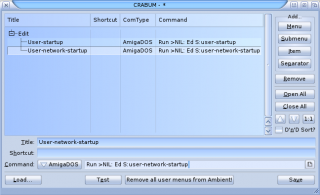
- Click the Save button to save the resulting ARexx script.
- If you save the file to the SYS:WBStartup drawer, it will be launched at boot time. Enter a suitable name for the file, for example Edit-menu. Click the Ok button.
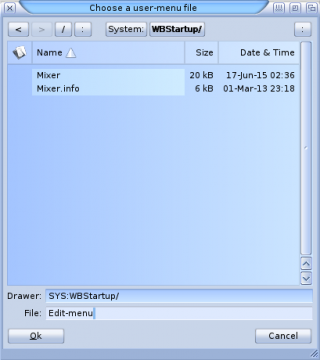
After a reboot (or doubleclicking of the file) you'll have the new Edit menu on the Ambient pulldown menus and you can easily open the system files for editing.
More Configuring
Synchronizing the Clock with Internet Time Server
The system clock can be synchronized manually from the MorphOS Preferences application by clicking the Set date and time using the Internet button in the Time preferences.
There's also the SetClockNTP shell command which can be launched manually or automatically at boot time. To synchronize the time every time the system starts edit the S:user-network-startup file and remove the semi-colon from the SetClockNTP line.
To edit the S:user-network-startup file open the shell (or the Execute Command prompt) and type Ed S:user-network-startup, or open the System partition, select the All Files mode, browse to the S directory and select the Edit... option from the right mouse button context menu. Or if you configured the Edit menu with CRABUM earlier, use it now.
Configuring the Shell
Editing the Shell-startup file
The shell can be customized with the shell-startup file, but by default the file is only found in a MorphOS system directory where user shouldn't do any modifications. It must be copied to user directories first to make any changes to it. Open a new shell window and type Copy MOSSYS:S/shell-startup SYS:S/shell-startup, and then edit it for example with the Ed SYS:S/shell-startup command. The shell-startup file is executed every time a new shell window is opened.
Adding Paths
There are some useful shell commands around the system which aren't in the system search path and you'll have to enter their complete path when using them. Adding their directories to the search path makes the usage much more convenient, because commands can then be run just by their names.
Here are few suggestions to add to the SYS:S/shell-startup file (remember the previous step first!). Or if you want them to be available globally in all occasions, they can be added to the S:user-startup file instead.
- Path SYS:Applications/RemoteShell/Files ADD adds SSH related commands like scp, sftp, ssh, etc to the search path.
- Path SYS:Applications/OWB/Datas ADD adds wget to the search path.
- Path SYS:Applications/MPlayer ADD adds MPlayer and mencoder to the search path if you have installed MPlayer. Change the path if you have installed it elsewhere.
Configuring the GUI
There are many buttons and hotkeys to add to the shell window besides the default ones. Check the preferences by selecting the Settings->Edit Prefs... option from the Shell's pulldown menus.
Available functions can be dragged to Hotkeys or Buttons lists and the changes are seen in real time on the shell window.
You may also want to set the default window size and position for new shell windows from the Settings tab. Click the Get from window button to get values from the current shell window.
Remember to save the modifications from the Settings menu.
